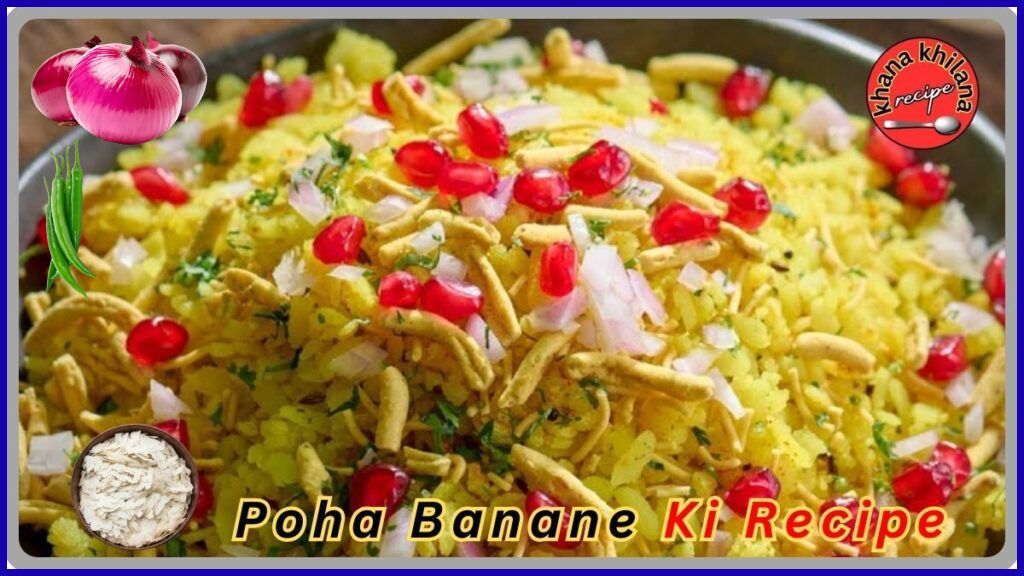Introduction – Hello friends, welcome to the ‘Khana KhilanaRecipe Blog’. Today we are going to share with you a quick and easy breakfast Poha Banane Ki Recipe.
Poha, also known as flattened rice, is a popular and delicious breakfast that originated in India. In many cities, roadside carts serve poha with a thin gravy and people love it. It is a quick recipe that is enjoyed by kids and people of all ages.
Poha is not only easy to make but also extremely nutritious. In this recipe, wash the poha with clean water and keep it for 5 minutes. Then in a pan add mustard and cumin seeds in cooking oil and add aromatic spices like coriander powder, turmeric powder, red chili powder, curry leaves and chopped onions and tomatoes along with salt.
Let it become transparent. After that, cook the soaked poha by mixing it well with all these spices, add chopped coriander leaves and lemon and serve. So let’s make this delicious Breakfast Poha recipe
Preparation Time: 15 min
Cooking Time: 20 min
Total Time: 30 min
Serves: 2 serving

Poha Banane Ki Recipe Ingredients:
- 2 cups – Poha
- 2 tablespoon – Cooking Oil
- 1 cup – Tomato (chopped)
- 1/2 cup – Onion (chopped)
- 1 – Green chilies (chopped)
- 2 – potato (fried in small pieces)
- 1/4 cup – Peanuts
- 1/2 teaspoon of mustard seeds
- 1/2 teaspoon – Cumin seeds
- 12 – Curry leaves
- 1 teaspoon – Coriander Powder
- 1/4 teaspoon – Turmeric powder
- 1/2 teaspoon – Salt (as per taste)
- 1 tablespoon – Fresh Coriander leaves (chopped)
- 1 tablespoon – Lemon juice
- 1/2 teaspn – Garam masala
Poha Banane Ki Recipe Instructions:
Step 2
Firstly you need to heat oil in a large pan or kadhai over medium heat. Add cumin seeds & mustard seeds. Once they start to crackle, add the peanuts and saute until they turn golden brown. Keep the flame low else the peanuts will get burnt.
Step 3
Step 4
After taking off flame Garnish with chopped fresh coriander leaves and chopped onions & serve hot. Add lemon juice to taste slightly sour. Lemon juice gives a wonderful flavor to the poha. Poha is usually eaten alone, but you can have it with crispy small sev or with tea or any vegetable gravy of your choice. So our Poha Banane Ki Recipe is ready.

Tips And Notes
1 – Always use fresh poha for the poha recipe and do not use poha with very thin leaves, use slightly thick leaves.
2 –Poha should not be kept in water for a long time, due to being soaked in water for a long time, it absorbs water, due to which the recipe gets spoiled.
3 – You can also add your favorite vegetables like carrot capsicum and boiled peas
Faq
Q: What is the benefit of eating poha?
Ans: Good source of carbohydrates: Poha is made from flattened rice flakes, which are a good source of carbohydrates.
Carbohydrates provide energy to the body and are essential for various bodily functions.
Q: Where is Pohs dish?
Ans: Poha is a popular dish that originated in the Indian subcontinent, particularly in the western states of Maharashtra, Gujarat, and Madhya Pradesh. It is commonly consumed as a breakfast or snack option in these regions.
Q: Does poha contain fat?
Ans: Poha itself is a low-fat food. It is made from flattened rice flakes with minimal fat content. However, adding oil or other fat sources during the cooking process can increase the overall fat content of the dish.

You May Also Like ⇓
In Conclusion
Welcome to the Khana Khilana Recipe Blog. Today we have told you about Poha Banane Ki Recipe. In this recipe, We told you poha after washing it with water, put mustard seeds and cumin seeds in a pan with oil and add some aromatic spices like coriander powder, turmeric powder, garam masala, salt, onion, and tomatoes, then route the poha in these spices. It is prepared by mixing well, adding peanuts, fried potato chopped coriander, and lemon, and serving hot. We hope you enjoy this recipe. Which recipe do you want to know about please write us our next recipe on the blog will be the same. Do write to us for any kind of advice and suggestions. We respect your valuable suggestion. Thank you.

Poha Banane Ki Recipe / Nutrition Value
Amount Per Serving 200 gm (one serving)
Energy➡ 220 kcal
Fat➡ 2 gm
Carbs➡ 46 gm
Protein➡ 5 gm

Hello, I am Rajeev Sharma. We welcome you to the khana khilana recipe blog. I share easy tips for cooking delicious and quick recipes on my blog. My aim is to share the art of cooking new and different types of tasty recipes with my readers so that their cooking experience becomes very easy.


Pingback: Chole Ki Sabji Recipe -
Pingback: Badam Shake Recipe -
Pingback: Makhane Ki Kheer Recipe - From Kitchen to Table: Exploring the World of Flavors
Pingback: Red Sauce Pasta Recipe - From Kitchen to Table: Exploring the World of Flavors
Pingback: Ghever Recipe - From Kitchen to Table: Exploring the World of Flavors
Pingback: Gajar Ka Halwa Recipe - From Kitchen to Table: Exploring the World of Flavors